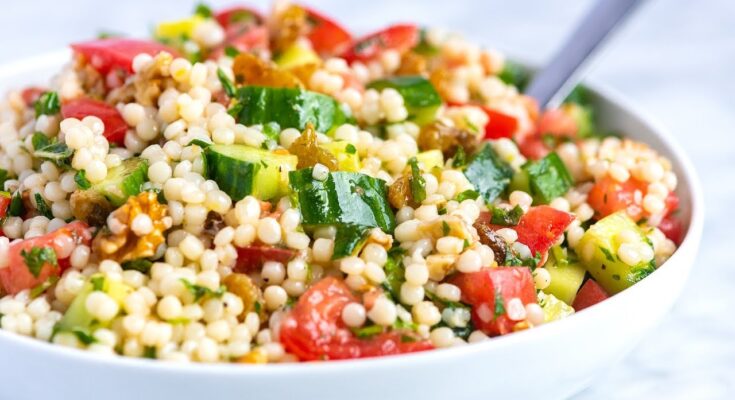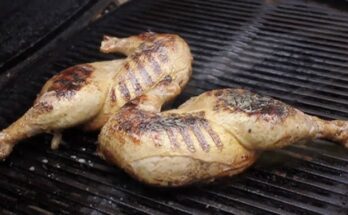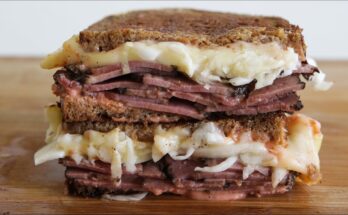Couscous Food Recipe: If you’ve ever wanted a quick, delicious, and healthy dish that can be enjoyed as a side or main course, couscous should be on top of your list. Couscous is a tiny grain-like pasta that’s incredibly versatile. It absorbs flavors beautifully, cooks faster than rice, and can be dressed up with vegetables, meats, or herbs.
In this guide, we’ll go through the full recipe, including ingredients, kitchen tools, and a step-by-step method to make fluffy couscous every single time. Whether you’re a beginner cook or someone who wants to expand your culinary skills, this couscous recipe will be your go-to option.
What is Couscous?
Couscous is often mistaken for a grain, but in reality, it is a type of pasta made from semolina flour. Originating from North Africa, particularly Morocco, Algeria, and Tunisia, couscous has been a staple in many households for centuries. It’s made by rolling crushed durum wheat semolina into tiny granules and then steaming them until fluffy. Traditionally, couscous is prepared using a special double-chambered steamer called a couscoussier. However, today most of us use instant couscous, which only requires hot water or broth to soften.
Couscous is more than just food—it’s a cultural symbol. In many North African countries, serving couscous represents hospitality and togetherness. Families gather around a large dish of couscous topped with vegetables and meat, sharing from the same plate. It’s not just about feeding the body but also nurturing bonds.
Why Couscous is Popular Worldwide
So, why has couscous become popular beyond its native regions? The answer is simple: convenience, versatility, and health benefits. Unlike rice, which may take 20 minutes or more to cook, couscous is ready in just 5 minutes. You can easily flavor it with herbs, spices, or even citrus zest to complement any dish. Moreover, couscous works well with various cuisines, whether you’re preparing a Mediterranean salad, a hearty Moroccan stew, or a simple weekday side dish.
Another reason for couscous’s popularity is its nutritional profile. It’s low in fat, a good source of complex carbohydrates, and provides essential vitamins and minerals like selenium. It’s also budget-friendly, making it accessible to almost everyone. With so many advantages, couscous deserves its place in kitchens around the world.
Ingredients You’ll Need
Main Ingredients for Basic Couscous
To prepare a simple and classic couscous dish, you only need a handful of ingredients. The beauty of couscous lies in its simplicity. Here’s the base recipe:
- 1 cup couscous (instant or traditional)
- 1 cup water or broth (vegetable, chicken, or beef broth for added flavor)
- 1 tablespoon olive oil or butter
- ½ teaspoon salt (adjust according to taste)
That’s it! These four ingredients form the foundation of your couscous. The broth makes a significant difference, so if you want richer flavors, always opt for stock instead of plain water.
Optional Additions for Flavor Enhancement
If you want to elevate your couscous, consider adding some extras:
- Chopped vegetables (carrots, zucchini, peas, bell peppers)
- Herbs (parsley, cilantro, mint, basil)
- Spices (cumin, turmeric, paprika, cinnamon)
- Dried fruits (raisins, apricots, cranberries)
- Nuts (almonds, pine nuts, pistachios)
- Lemon zest or juice for brightness
These optional additions transform plain couscous into a gourmet dish. You can play around with the flavors depending on the occasion—savory for dinner, fresh and light for summer salads, or rich and spiced for festive gatherings.
Choosing the Right Couscous (Instant vs Traditional)
There are mainly two types of couscous available in the market:
- Instant Couscous – This is pre-steamed and dried. You only need to soak it in hot water or broth for about 5 minutes. It’s the most common type found in supermarkets and is perfect for busy lifestyles.
- Traditional Couscous – This requires steaming, usually in a couscoussier. The process is longer and more authentic, resulting in a fluffier texture and deeper flavor.
If you’re new to couscous, start with instant couscous. It’s simple, foolproof, and still delicious. But if you ever want to experience authentic North African cooking, try making traditional couscous—it’s worth the effort.
Kitchen Tools and Equipment Required
Essential Cooking Tools
Couscous doesn’t demand fancy tools. In fact, most of what you need is already in your kitchen. Here’s what you’ll require:
- A medium saucepan (with a lid) for boiling water or broth.
- A heatproof bowl (if using instant couscous).
- A fork (for fluffing couscous).
- A measuring cup and spoon for accuracy.
These basics are enough to get started.
Helpful Extras for Better Cooking Results
If you want to go a step further, here are some extras that can make cooking couscous easier and more authentic:
- A couscoussier (traditional double-chambered steamer).
- A wooden spoon for mixing ingredients gently.
- A large serving platter for presenting couscous in a family-style meal.
- A steamer basket (if you want to steam vegetables directly over couscous).
Having the right tools makes cooking more enjoyable and helps you achieve perfect results. But don’t worry—even with just a pot and a fork, you can create a fluffy, delicious couscous dish.
Step-by-Step Guide to Making Couscous
Step 1 – Preparing the Ingredients
The first step in making couscous is gathering and preparing all your ingredients. Start by measuring your couscous and liquid. Remember, the golden ratio is 1:1—one cup of couscous to one cup of water or broth. This ratio ensures fluffy results every time.
Next, chop any vegetables, herbs, or garnishes you’d like to include. If you’re planning on adding dried fruits or nuts, have them ready as well. Preparation is key because couscous cooks quickly, and you won’t have much time once the liquid starts boiling.
Another important tip is to warm your broth beforehand. Using warm or hot broth instead of cold liquid helps the couscous absorb flavors faster and more evenly.
At this stage, think of couscous like a blank canvas—you decide the flavors and textures you want to highlight. Whether you keep it simple with butter and herbs or go bold with spices and roasted veggies, couscous adapts beautifully.
Step 2 – Measuring and Boiling the Liquid
The heart of good couscous lies in the liquid you use. While plain water works fine, broth (vegetable, chicken, or beef) elevates the taste significantly. To begin, measure your liquid precisely. The perfect ratio is 1:1 — one cup of couscous to one cup of liquid. If you want a slightly softer couscous, you can add a little more liquid, but never too much, or you’ll end up with mushy grains.
Pour the liquid into a saucepan and bring it to a gentle boil. At this stage, you should also add olive oil or butter and a pinch of salt. The oil or butter keeps the couscous grains from sticking together and adds richness to the flavor. If you’re adventurous, you can drop in a bay leaf, a pinch of saffron, or even a stick of cinnamon to infuse more depth.
As the liquid heats, you’ll notice how the aromas fill your kitchen. That’s the magic of using broth instead of plain water—the couscous absorbs every bit of that flavor. Once the liquid reaches a rolling boil, turn off the heat. This step is crucial because couscous doesn’t cook on direct heat—it steams and absorbs liquid instead.
Boiling the liquid properly ensures the couscous is evenly cooked and fluffy. Think of this stage as laying the foundation for the final dish. Without the right liquid and correct boiling, even the best-quality couscous can fall flat.
Step 3 – Adding Couscous and Letting it Steam
Now comes the simplest yet most important step: combining couscous with the hot liquid. Once your broth or water is boiling, immediately remove it from the heat. Add your couscous directly into the pot, stir quickly to ensure even distribution, and then cover it with a lid.
The couscous will begin absorbing the liquid almost instantly. Leave it covered for about 5 minutes. During this time, the grains swell, soften, and soak up all the flavors. It’s tempting to peek or stir, but resist the urge! Lifting the lid too early lets steam escape, which can result in uneven cooking.
If you’re using instant couscous, this steaming process is usually enough. However, for traditional couscous, the method is different. Traditional couscous is steamed multiple times in a couscoussier, with breaks in between to sprinkle with water and break up clumps by hand. While it takes longer, the result is lighter and fluffier grains.
After 5 minutes, remove the lid, and you’ll see perfectly softened couscous. But don’t dive in just yet—the next step is where the magic happens.
Step 4 – Fluffing the Couscous Properly
Fluffing couscous is the secret to turning it from sticky mush into a light, airy dish. Grab a fork and gently run it through the couscous, breaking apart any clumps. Never use a spoon for this step—it tends to press the grains together rather than separate them.
As you fluff, you’ll see the couscous transform into delicate, individual grains. If you want to enhance the flavor, this is the best time to mix in extras like chopped herbs, roasted vegetables, nuts, or spices. For example, adding fresh parsley or cilantro gives it a refreshing taste, while a sprinkle of cumin or paprika creates warmth and depth.
Some chefs also drizzle in a little extra olive oil or melted butter while fluffing. This coats the grains lightly, preventing them from sticking and making them shine. It also adds a beautiful richness to the final dish.
Fluffing is more than just a cooking technique—it’s the step that gives couscous its signature texture. Done correctly, every bite will feel light yet satisfying, making it the perfect side dish or base for a hearty meal.
Step 5 – Final Touches and Serving Suggestions
By now, your couscous is cooked, fluffy, and ready to serve—but why stop there? Couscous is a versatile base that welcomes creativity. Depending on your mood or occasion, you can dress it up in endless ways.
For a simple side dish, drizzle with olive oil, sprinkle with salt and pepper, and maybe toss in a handful of fresh herbs. If you’re making a main course, consider topping it with sautéed vegetables, grilled chicken, roasted lamb, or spiced chickpeas. For a refreshing summer meal, turn it into a salad by adding cucumbers, tomatoes, olives, and a splash of lemon juice.
Serving style also matters. Traditionally, couscous is served on a large platter with the toppings arranged beautifully on top, encouraging everyone to share. It’s a communal dish that brings people together, making it perfect for family dinners or gatherings.
Don’t forget garnishes. A sprinkle of toasted almonds, raisins, or pomegranate seeds not only adds texture and color but also balances savory flavors with a hint of sweetness. Pair your couscous with yogurt-based sauces, harissa, or even a drizzle of tahini for an extra layer of flavor.
Couscous is more than food—it’s an experience. With a little creativity, you can make it the star of any meal, whether it’s a weekday dinner or a festive celebration.
Variations of Couscous Dishes
Couscous on its own is delicious, but the real fun begins when you start experimenting with variations. From hearty meat-based recipes to light and refreshing salads, couscous adapts beautifully to different flavors and cooking styles. Below are some of the most popular and tasty couscous variations you can try at home.
Vegetable Couscous
Vegetable couscous is a vegetarian delight that combines fluffy couscous with a medley of fresh, colorful vegetables. Typically, carrots, zucchini, bell peppers, onions, and chickpeas are simmered in a lightly spiced broth with ingredients like cumin, coriander, and cinnamon. Once tender, the vegetables are layered over couscous, creating a wholesome dish packed with flavor and nutrition.
The best part about vegetable couscous is its flexibility. You can make it with whatever vegetables you have on hand, and it’s just as delicious with seasonal produce. Want to add some sweetness? Toss in raisins or dried apricots. Craving crunch? Top with toasted almonds or pine nuts. This dish works equally well as a main course for vegetarians or as a side dish alongside grilled meats or fish.
Chicken Couscous
Chicken couscous is hearty, comforting, and full of flavor. In this version, chicken pieces are cooked with onions, garlic, and spices before being simmered in broth. Vegetables such as carrots, turnips, and zucchini are often added, creating a rich stew that’s then poured over a bed of couscous.
To take chicken couscous up a notch, you can marinate the chicken in spices like turmeric, paprika, and ginger before cooking. This adds depth and complexity to the dish. Garnish with fresh parsley or cilantro, and you’ll have a complete, well-balanced meal that’s both filling and satisfying.
Moroccan-Style Couscous
When most people think of couscous, Moroccan-style couscous is what comes to mind. This version is iconic and typically includes a mix of lamb, chicken, or beef simmered with vegetables and spices such as cinnamon, turmeric, saffron, and cumin. The dish often features sweet elements like dried apricots, raisins, or prunes, balanced with savory flavors for a perfect blend of tastes.
Moroccan couscous is traditionally served on Fridays as part of family gatherings. It’s usually presented in a large communal dish, with the couscous spread out as the base and the meat and vegetables placed on top. The rich broth is spooned over everything, ensuring every bite is packed with flavor.
Mediterranean Couscous Salad
For a lighter take, a Mediterranean couscous salad is a refreshing option. This version combines couscous with ingredients like cucumbers, cherry tomatoes, red onions, feta cheese, olives, and fresh herbs. Dressed with olive oil, lemon juice, and a touch of garlic, it’s the perfect summer dish.
Mediterranean couscous salad can be served chilled or at room temperature, making it great for picnics, barbecues, or lunchboxes. It’s not just healthy but also vibrant, colorful, and bursting with fresh flavors. This variation highlights couscous’s versatility, proving it’s more than just a side dish.
Nutritional Benefits of Couscous
Couscous is not just tasty—it’s also packed with nutritional value that makes it a great addition to a balanced diet. Whether you’re looking for energy, vitamins, or a lighter alternative to heavier grains, couscous has plenty to offer.
Couscous as a Source of Energy
Couscous is made from durum wheat semolina, which is rich in complex carbohydrates. These carbs break down slowly, providing steady energy throughout the day rather than causing sudden spikes and crashes. That’s why couscous is a favorite among people who need sustained energy—athletes, busy professionals, and even children.
Unlike refined carbs like white bread or pasta, couscous in its whole-grain form is healthier, giving you longer-lasting fuel for your body and mind.
Vitamins, Minerals, and Fiber Content
Couscous contains essential nutrients, including selenium, a powerful antioxidant that supports immune function and reduces inflammation. It also provides small amounts of B vitamins, which help in energy production and maintaining brain health. Whole-grain couscous is particularly rich in dietary fiber, which aids digestion, prevents constipation, and keeps you feeling fuller for longer.
Fiber also plays a role in heart health by reducing cholesterol levels and supporting healthy blood sugar control. Adding vegetables, legumes, or lean proteins to couscous enhances its nutritional profile even further, turning it into a well-rounded meal.
Couscous vs Other Grains
When comparing couscous to other grains like rice or quinoa, couscous has some advantages. It cooks much faster than rice, taking just 5 minutes to prepare. Compared to quinoa, it has a milder flavor, making it easier to adapt to different dishes. However, quinoa is gluten-free and higher in protein, so couscous may not be the best option for people with gluten intolerance.
Still, couscous holds its own as a versatile, nutritious option that’s perfect for busy lifestyles. By choosing whole-grain couscous, you get more fiber and nutrients, making it a smart choice for health-conscious eaters.
Tips and Tricks for Perfect Couscous Every Time
Even though couscous is simple to make, small mistakes can affect the texture and taste. Follow these tips to ensure perfect results every time.
Common Mistakes to Avoid
- Using too much liquid – This makes couscous mushy and heavy. Stick to the 1:1 ratio.
- Skipping the fluffing step – If you don’t fluff with a fork, couscous will clump together.
- Lifting the lid too early – Letting steam escape before the couscous fully absorbs the liquid can result in uneven cooking.
- Not seasoning the liquid – Couscous absorbs the flavor of whatever it’s cooked in, so season the broth well.
How to Store and Reheat Couscous
Couscous is great for meal prep because it stores well. Once cooked, let it cool completely before placing it in an airtight container. It will last in the refrigerator for up to 4 days. To reheat, sprinkle a little water over the couscous, cover it, and microwave for 1–2 minutes. Alternatively, you can reheat it on the stovetop with a splash of broth.
If you want to freeze couscous, portion it into freezer-safe bags or containers. When ready to eat, thaw overnight in the fridge and reheat as usual. This makes couscous a convenient dish for busy weeks when you want something quick and healthy.
Serving Ideas and Pairings
Couscous is a blank canvas, making it one of the most versatile dishes you can serve. Depending on your choice of toppings and sides, it can shine as a main dish or complement other meals beautifully.
Couscous with Meat Dishes
Pair couscous with roasted lamb, grilled chicken, or even pan-seared fish for a hearty meal. The lightness of couscous balances rich, savory meats, creating a satisfying and well-rounded plate.
Couscous as a Vegetarian Option
For vegetarians, couscous pairs beautifully with roasted vegetables, chickpeas, lentils, or tofu. Add spices and herbs to keep it flavorful, and you’ll have a filling, plant-based meal that’s both nutritious and delicious.
Couscous in Salads and Side Dishes
Couscous salads are perfect for light lunches or side dishes. Mix couscous with fresh veggies, feta cheese, olives, and a lemon-olive oil dressing for a Mediterranean-style salad. You can also serve couscous as a simple side dish alongside soups, curries, or stews.
FAQs about Couscous Food Recipe
1. Can I cook couscous without boiling water?
No, couscous needs hot water or broth to soften and cook properly. However, you don’t always need to boil it on the stove—just pour boiling water over couscous in a bowl, cover, and let it steam.
2. How do I make couscous fluffy instead of sticky?
Always use the 1:1 ratio of liquid to couscous, let it steam covered for 5 minutes, and fluff with a fork immediately after. Adding olive oil or butter also helps.
3. Is couscous gluten-free?
No, couscous is made from durum wheat, so it contains gluten. People with gluten intolerance or celiac disease should avoid it and opt for gluten-free alternatives like quinoa or millet.
4. How long does cooked couscous last in the fridge?
Cooked couscous can last up to 4 days in the refrigerator when stored in an airtight container. For longer storage, you can freeze it for up to 3 months.
5. What spices go best with couscous?
Popular spices include cumin, paprika, turmeric, cinnamon, and coriander. Fresh herbs like parsley, mint, or cilantro also pair wonderfully.
Conclusion
Couscous is more than just a quick-cooking grain—it’s a versatile, flavorful, and nutritious dish that adapts to countless variations. From traditional Moroccan feasts to refreshing Mediterranean salads, couscous proves it can be both hearty and light, simple and gourmet. By following the step-by-step guide, experimenting with different flavors, and applying the right tips, you’ll be able to make perfect couscous every time. Whether served as a side dish or the star of your meal, couscous is a recipe worth mastering.



